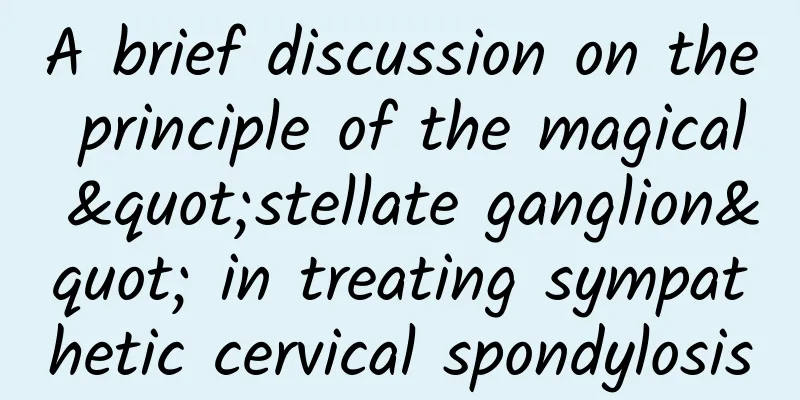A brief discussion on the principle of the magical "stellate ganglion" in treating sympathetic cervical spondylosis

|
In recent years, the number of people suffering from cervical spondylosis has been increasing year by year, which may be related to the popularization of computers, the accelerated pace of society, and the long hours of "head-down tribe" working at their desks. When you experience occipital pain, dizziness, tinnitus, blurred vision, anxiety, depression, memory and cognitive disorders, and pseudo-angina, you need to be alert to the possibility of sympathetic cervical spondylosis. Ms. Wang, 36 years old, is a mother who has suffered from neck and shoulder pain for more than a year. She just gave birth to her second child two months ago. Recently, her neck and shoulder pain has worsened, as well as paroxysmal chest pain, accompanied by dizziness, palpitations, chest tightness, and occasional nausea. The fatigue of taking care of the child for two months made her even more worried and anxious. Her family was worried that she had "postpartum depression". She visited several clinics of our hospital for a series of examinations on the brain, cervical spine, heart, etc., but no obvious abnormalities were found. The effect of psychological counseling and drug treatment was not significant. Finally, she was introduced by a cardiologist to come to the outpatient clinic of Director Zhang Zhili of the Pain Department of Qinhuangdao First Hospital. After a careful physical examination by Director Zhang and combined with previous auxiliary examinations, other internal diseases were ruled out and sympathetic cervical spondylosis was considered. Sympathetic cervical spondylosis is a series of clinical symptoms caused by various structural lesions of the cervical spine stimulating the sympathetic nerves, including occipital pain, nystagmus when the head moves, tinnitus, blurred vision, and corneal hyperesthesia. Other symptoms include anxiety, depression, and memory and cognitive disorders. Because the affected parts are extremely complex, it is extremely difficult to diagnose clinically and needs to be differentiated from a series of internal medicine diseases. It is also a disease that is easily misdiagnosed clinically. After research, Director Zhang Zhili's team diagnosed Ms. Wang with sympathetic cervical spondylosis, and the first step of the treatment plan was to perform ultrasound-guided stellate ganglion block. Stellate ganglion block is a minimally invasive treatment method commonly used in the pain department. It is a reversible block of the sympathetic nerves that control the head, face, neck, upper limbs and upper chest by injecting local anesthetics and other drugs into the loose connective tissue containing the stellate ganglion. The operation is simple and easy to perform using ultrasound guidance. It has the advantages of correctly selecting the puncture point, shortening the puncture time, accurately controlling the depth of the needle, improving the success rate of the puncture, and avoiding blind puncture to damage adjacent important organs. It not only improves the success rate but also reduces complications. The sign of a successful block is the appearance of Horner syndrome, which manifests as pupil constriction, ptosis, sunken eyeballs, nasal congestion, conjunctival congestion, slightly red face, and no sweat on the face. After several treatments, Ms. Wang's symptoms of neck and shoulder pain, chest pain and tightness, palpitations, and restlessness were basically relieved. In the second step, in order to consolidate and maintain the treatment effect, Ms. Wang received "green" neuromodulation treatment of pulsed high-voltage radiofrequency modulation of the stellate ganglion under ultrasound guidance. Pulsed radiofrequency is a neuromodulation technology that uses pulsed current below 42°C on the target nerves to avoid dependence on temperature damage and prevent nerve damage. This method can effectively improve the patient's vertebral artery blood flow and clinical symptoms and reduce the patient's pain level. After treatment, the symptoms that had troubled Ms. Wang for a long time were finally relieved, and she was discharged from the hospital with satisfaction! The magical stellate ganglion block is not only an effective treatment for sympathetic cervical spondylosis, but also has a wide range of applications and significant effects, including: 1. Systemic diseases: autonomic dysfunction, insomnia, hyperhidrosis, vertigo, skin itching, post-stroke pain, post-herpetic pain, chronic fatigue syndrome, phantom limb pain, diabetes, etc. 2. Head and facial diseases: migraine, tension headache, cerebral thrombosis, cerebral vasospasm, cerebral infarction, nerve paralysis, atypical facial pain, etc. 3. Eye and ENT diseases: floaters, visual fatigue, allergic rhinitis, Meniere's disease, benign paroxysmal vertigo, tinnitus, etc. 5. Respiratory and circulatory system diseases: angina pectoris, sinus tachycardia, cardiac neurosis, chronic bronchitis, pulmonary embolism, bronchial asthma, etc. 6. Digestive system diseases: ulcerative colitis, gastritis, gastric ulcer, intestinal obstruction, constipation, diarrhea, etc. 7. Urinary and reproductive system diseases: abnormal menstruation, premenstrual tension disorder, menopausal syndrome, neurogenic urinary frequency, nocturia, urinary incontinence, prostatitis, etc. 8. Diseases of the body and limbs: cervical spondylosis, cervical-shoulder-arm syndrome, periarthritis of the shoulder, redness, swelling and pain in the extremities, cyanosis, thromboangiitis obliterans, bone hyperplasia, degenerative osteoarthritis, low back pain, etc. It should be noted that stellate ganglion block is risky and requires evaluation by an experienced pain specialist before it can be performed. Pain is a disease. Pain specialists specialize in treating various stubborn pains that are not effectively treated by other departments. They analyze the causes and mechanisms of pain, and provide medication, nerve block therapy, various nerve regulation and nerve destruction and other minimally invasive interventional surgeries. They also provide psychological intervention when necessary. Through comprehensive treatment, they effectively relieve symptoms and improve the quality of life. |
<<: How much do you know about the causes and treatments of cervical spondylosis?
>>: Hepatitis B vaccination for children: protecting children's health
Recommend
Can I get pregnant if I have uterine fibroids?
Uterine fibroids are a benign tumor. It is a rela...
The blood vessels that the human body fears most are blocked! Many cerebral infarctions and strokes are related to them! Teach you 4 ways to improve carotid artery plaques
Carotid artery, the blood vessel that the human b...
The cause of irregular menstruation is actually because of this matter
In addition to causing inconvenience to women, ir...
See the other side of a woman from her eating habits
Although men eat in many different ways, they pal...
I still have blood four days after the abortion.
Bleeding after an abortion is a relatively normal...
Anti-aging doesn’t just stop at the surface of the skin, new research shows!
When we talk about anti-aging, many people first ...
What is mild polycystic ovary syndrome?
Many women should have some gynecological disease...
High sugar and high fat content? Understand these 5 things to eat mooncakes safely!
Tuchong Creative In the cool and refreshing days ...
Abdominal pain every time after urinating
Some women experience lower abdominal pain after ...
Guangdong people are heartbroken! Is the smooth and chewy rice noodle roll possibly poisonous? Also be careful about these 4 kinds of food →
Recently, the Guangdong Provincial Market Supervi...
How many days is the confinement period after miscarriage?
The time of confinement after miscarriage is the ...
Can I have sex after inserting the pill at night?
Women often use suppositories to treat inflammati...
Is a slimming belt harmful to the body?
Nowadays, as more and more people want to lose we...
Can I drink soy milk during postpartum breastfeeding?
Soy milk is mainly a drink made from soy products...
Nine-valent vaccine for girls
As we all know, cervical cancer is one of the can...









